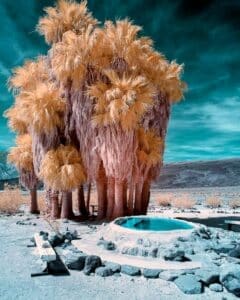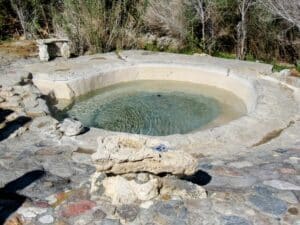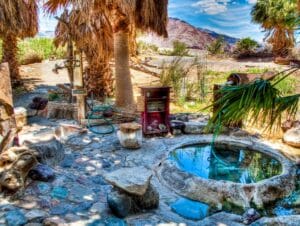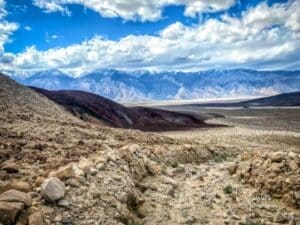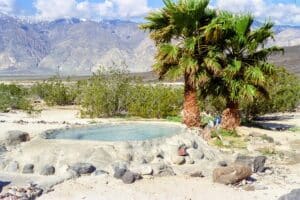“Exploring the Saline Valley Hot Springs of Death Valley National Park”
Death Valley National Park is known for its extreme temperatures and arid landscape.
Did you know it also boasts a variety of hot springs?
One of the most unique and lesser-known hot springs in the park is the Saline Valley Hot Springs.
Saline Valley is a remote desert valley in Death Valley National Park in California, USA.
The valley is known for its hot springs.
Located on Bureau of Land Management land and accessible by a 50-mile-long dirt road.
The hot springs have several pools with varying temperatures.
Including Lower Warm Springs, Palm Spring, and Upper Warm Spring.
- Discover Saline Valley Hot Springs: A Remote Desert Oasis in California
- Introduction to Saline Valley Hot Springs
- Where Are Saline Valley Hot Springs?
- What Makes Saline Valley Hot Springs Unique?
- How to Get to Saline Valley Hot Springs
- Tips for Visiting Saline Valley Hot Springs
- Nearby Attractions
- Why Visit Saline Valley Hot Springs?
- Saline Valley Hot Springs Location and Accessibility
- Saline Valley Hot Springs
- History of the Saline Hot Springs
- North or South Entrance to Saline Valley
- Weather Saline Valley Death Valley
- The 50-Mile-Long Dirt Road That is Unpaved
Discover Saline Valley Hot Springs: A Remote Desert Oasis in California
Explore Saline Valley Hot Springs, a secluded natural hot spring in California’s desert wilderness.
Learn about its geothermal pools, remote location, and tips for visiting this hidden gem near Death Valley National Park.
Introduction to Saline Valley Hot Springs
Nestled in the heart of California’s rugged desert landscape.
Saline Valley Hot Springs is a hidden gem for adventurers and nature lovers.
These natural hot springs offer a unique opportunity to soak in geothermal pools surrounded by breathtaking desert scenery.
Located in Inyo County, this remote desert oasis is a perfect escape for those seeking solitude and relaxation.
Where Are Saline Valley Hot Springs?
Saline Valley Hot Springs is situated in Saline Valley, a remote area within California’s Inyo County.
The springs are located near the boundaries of Death Valley National Park.
Making them a popular side trip for visitors exploring the region.
The area is managed by the Bureau of Land Management (BLM).
Ensuring its preservation as a natural treasure.
What Makes Saline Valley Hot Springs Unique?
Unlike commercialized hot springs.
Saline Valley Hot Springs offers a truly wild and natural experience.
The geothermal pools are maintained by volunteers and feature varying temperatures.
Allowing visitors to find their perfect soaking spot.
The surrounding desert landscape, with its stark beauty and serene atmosphere, adds to the allure of this remote hot spring.
How to Get to Saline Valley Hot Springs
Reaching Saline Valley Hot Springs requires a sense of adventure.
The springs are accessible via rough dirt roads.
So a high-clearance vehicle is recommended.
The journey takes you through the Saline Valley Salt Tram area.
Historic site that adds a touch of intrigue to the trip.
Be sure to bring plenty of water, food, and supplies.
This secluded desert oasis is far from amenities.
Tips for Visiting Saline Valley Hot Springs
- Plan Ahead: Check road conditions and weather forecasts before your trip.
- Pack Essentials: Bring water, food, sunscreen, and warm clothing for cooler evenings.
- Respect the Environment: Follow Leave No Trace principles to preserve the natural beauty of the area.
- Soak Responsibly: Be mindful of other visitors and share the soaking pools respectfully.
Nearby Attractions
While visiting Saline Valley Hot Springs.
Consider exploring other nearby attractions:
- Death Valley National Park: Known for its dramatic landscapes and unique geological features.
- Saline Valley Salt Tram: A historic tramway that once transported salt from the valley.
- Inyo County’s Desert Wilderness: Perfect for hiking, stargazing, and photography.
Why Visit Saline Valley Hot Springs?
Saline Valley Hot Springs is more than just a place to soak—it’s an experience.
Whether you’re drawn to its natural geothermal pools, the tranquility of the desert, or the challenge of reaching this remote hot spring.
It is a destination that leaves a lasting impression.
For those seeking an off-the-grid adventure, this desert oasis is a must-visit.
Saline Valley Hot Springs offers a one-of-a-kind experience for those willing to venture off the beaten path.
From its natural soaking pools to its stunning desert surroundings,
This remote hot spring is a testament to the beauty of California’s wilderness.
Plan your trip today and discover why Saline Valley Hot Springs is a beloved destination for adventurers and nature enthusiasts alike.
Saline Valley Hot Springs Location and Accessibility
The Saline Valley Hot Springs is located in the southern part of Death Valley.
Nnear the park’s boundary with the Mojave National Preserve.
The hot springs are accessible via a dirt road that branches off from the main park road.
The road is rough and requires a high-clearance vehicle.
The journey is well worth it for the secluded and scenic setting of the hot springs.
Saline Valley Hot Springs
The Springs Themselves
The Saline Valley Hot Springs consists of several pools of varying sizes, temperatures, and mineral content.
The water in the pools is a milky blue due to the high amount of dissolved minerals, particularly boron and lithium.
Lower Warm Springs
The Lower Warm Springs in Saline Valley offer visitors a chance to relax in natural soaking pools.
As of 2011, the lower pool is consistently filled with warm spring water and has a temperature of 110 °F.
Palm Spring
Palm Spring, located nearby, is another popular spot for visitors looking to soak in the warm waters.
The spring is home to two primitive soaking pools, including the Wizard Pool, known for its high temperatures between 105 °F and 112 °F.
The Wizard Pool has been constructed with rock and concrete, with seating built around it.
On the other hand, the Volcano Pool is more excellent, with temperatures ranging from 98°F to 104°F, and is above ground, unlike the Wizard Pool, which is below ground.
Upper Warm Spring
For those looking for even warmer water, the Upper Warm Spring has two soaking pools, one with a small sand-bottomed pool and a fantastic water pool.
Water from the upper spring emerges from the source at a temperature range of 98°F to 112°F.
All the pools are natural and natural-built and perfect for relaxing and unwinding.
The temperature of the water ranges from hot to very hot, with the largest pool reaching temperatures of up to range: 98°F to 112°F degrees Fahrenheit.
The hot springs are surrounded by natural rock formations and are a popular spot for stargazing.
However, visitors should be aware that there are no amenities at the hot springs and they should come prepared with water, food, and supplies.
A Unique Experience
The Saline Valley Hot Springs offer a unique and secluded hot spring experience in Death Valley National Park.
The mineral-rich waters and scenic setting make for a relaxing and rejuvenating experience.
Visitors should come prepared for a wild and remote adventure, but the journey is worth the chance to experience the hot springs in their natural setting.
History of the Saline Hot Springs
The Saline Hot Springs has a rich history dating back to the Timbisha Shoshone tribe, who have lived there for thousands of years.
They believed the hot springs had healing properties and would use the minerals in the water for medicinal purposes.
The hot springs have also been used by early settlers, prospectors, and even the military during World War II.
In the late 1960s, hippies discovered hot springs on the Bureau of Land Management land in Saline Valley.
They began visiting the area regularly to soak in the thermal pools and escape the fast-paced lifestyle of modern society.
Over time, this gathering of like-minded individuals has evolved to include a diverse group of people.
Including bohemians, loners, tourists, and others who share a love for hot springs and a desire for a peaceful and secluded getaway.
The hot springs continue to be a popular destination for those looking to disconnect from the demands of everyday life and unwind in the natural setting.
Conservation Efforts
Saline Valley Hot Springs are a unique and fragile ecosystem, and protecting them for future generations to enjoy is essential.
The National Park Service has implemented conservation efforts such as limiting the number of visitors.
Enforcing a carry-in carry-out policy, and monitoring water quality to ensure that the hot springs are not damaged by human activity.
Tips for Visiting
- Plan and come prepared with a high-clearance vehicle, as the road to the hot springs can be rough and may require a 4-wheel drive.
- Bring plenty of water, as no drinking water sources exist at the hot springs.
- Pack out all trash and waste to help preserve the natural setting of the hot springs.
- Be mindful of the temperature and time, as the hot springs can get extremely hot during summer.
- Be respectful of other visitors and nature and follow posted rules and guidelines.
In conclusion, the Saline Hot Springs is a unique and memorable part of Death Valley National Park that offers visitors a chance to uniquely experience the park’s natural beauty and history.
Taking the necessary precautions, being prepared, and respecting the environment and other visitors while exploring the area are essential.
North or South Entrance to Saline Valley
The Saline Valley Hot Springs can be accessed from the north or south entrance.
The Saline Valley Hot Springs is located in the northeastern region of Death Valley National Park and can be accessed via two main routes:
The North Pass goes through Big Pine, and the South Pass goes through Olancha.
Both routes are unpaved, long, and dangerous; it is essential to check the road conditions before heading out and to come prepared with the appropriate vehicle and supplies.
Due to the remote nature of the hot springs, it’s also important to let someone know your plans and expected arrival time, as the road is remote, and cell phone service can be spotty.
This road can only access the hot springs, and there is no other way to reach the springs.
This route is considered to be more challenging, as the road is more rugged and may require a high clearance vehicle or 4-wheel drive.
This route is also longer and passes through some remote and rough terrain.
Regardless of your entrance, it’s essential to check the road conditions in advance and come prepared with the appropriate vehicle and supplies.
Both routes can be impassable during the rainy season, and temperatures can reach over 120 degrees Fahrenheit in the summer.
It’s also important to let someone know your plans and expected arrival time, as cell phone service can be spotty in the area.
Chicken Strip for Small Aircraft for Landing and Takeoff
The Saline Valley Hot Springs is near an informal dirt landing strip called “The Chicken Strip.”
This strip is not controlled by a tower and is made up of a dirt surface; it is used by small aircraft for landing and takeoff.
It is important to note that the Chicken Strip is not a formal airport and may not have the same level of safety or maintenance as a commercial airport.
It is also essential to check the conditions of the strip before landing or taking off.
Weather Saline Valley Death Valley
The weather in Saline Valley, located within Death Valley National Park, can vary greatly depending on the time of year and elevation.
Summer temperatures in Saline Valley can reach over 120 degrees Fahrenheit and be extremely hot during the day.
Therefore, it’s essential to be prepared for the heat and bring plenty of water, sunscreen, and a wide-brimmed hat.
Winter temperatures are milder, with daytime highs averaging in the 50s and 60s, and nighttime lows can drop below freezing.
Visitors should be prepared for colder weather, bring warm clothing, and know about the risk of flash floods and storms.
The area receives very little rainfall, with most rain falling between November and April.
Visitors should be aware of the risk of flash floods and be prepared for rapidly changing weather conditions.
It’s always recommended to check the weather forecast and be prepared for any conditions before entering the park.
The Saline Valley Hot Springs is a hidden gem in Death Valley National Park, offering a unique and secluded hot spring experience.
While the journey to the hot springs is rough and remote, the mineral-rich waters and scenic setting make for a relaxing and rejuvenating experience.
So, pack your bags and don’t forget to bring your supplies, and head out to explore this unique and beautiful spot in Death Valley.
The 50-Mile-Long Dirt Road That is Unpaved
“Accessing the Saline Valley Hot Springs requires a journey on a 50-mile long dirt road that is unpaved and lacks facilities.
This road can be challenging and may require a high-clearance vehicle or 4-wheel drive.
It is essential to check the road conditions before heading out and to come prepared with the appropriate vehicle and supplies.
It’s also important to let someone know your plans and expected arrival time as this remote road and cell phone service can be spotty.”
We highly recommend this Saline Valley Hot Springs adventure.
Be prepared and plan on spending a few days.
We will see you at the following hot springs adventure.
Saline Valley Hot Springs
Saline Valley Hot Springs
When buying or selling Las Vegas homes for sale.
Contact an experienced Realtor!
Saline Valley Hot Springs
